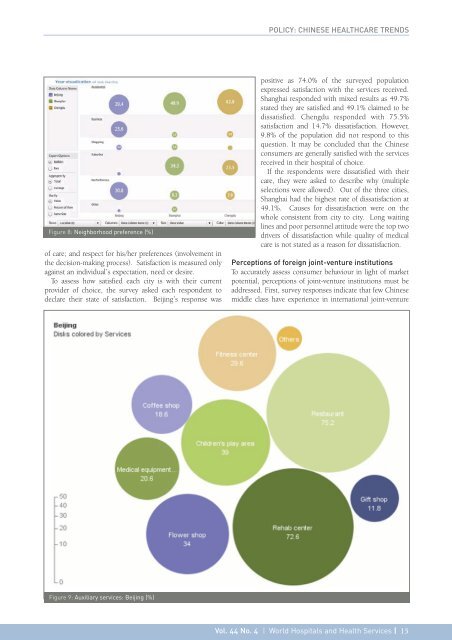World Hospitals and Health Services - International Hospital ...
World Hospitals and Health Services - International Hospital ...
World Hospitals and Health Services - International Hospital ...
Create successful ePaper yourself
Turn your PDF publications into a flip-book with our unique Google optimized e-Paper software.
POLICY: CHINESE HEALTHCARE TRENDS<br />
Figure 8: Neighborhood preference (%)<br />
of care; <strong>and</strong> respect for his/her preferences (involvement in<br />
the decision-making process). Satisfaction is measured only<br />
against an individual’s expectation, need or desire.<br />
To assess how satisfied each city is with their current<br />
provider of choice, the survey asked each respondent to<br />
declare their state of satisfaction. Beijing’s response was<br />
positive as 74.0% of the surveyed population<br />
expressed satisfaction with the services received.<br />
Shanghai responded with mixed results as 49.7%<br />
stated they are satisfied <strong>and</strong> 49.1% claimed to be<br />
dissatisfied. Chengdu responded with 75.5%<br />
satisfaction <strong>and</strong> 14.7% dissatisfaction. However,<br />
9.8% of the population did not respond to this<br />
question. It may be concluded that the Chinese<br />
consumers are generally satisfied with the services<br />
received in their hospital of choice.<br />
If the respondents were dissatisfied with their<br />
care, they were asked to describe why (multiple<br />
selections were allowed). Out of the three cities,<br />
Shanghai had the highest rate of dissatisfaction at<br />
49.1%. Causes for dissatisfaction were on the<br />
whole consistent from city to city. Long waiting<br />
lines <strong>and</strong> poor personnel attitude were the top two<br />
drivers of dissatisfaction while quality of medical<br />
care is not stated as a reason for dissatisfaction.<br />
Perceptions of foreign joint-venture institutions<br />
To accurately assess consumer behaviour in light of market<br />
potential, perceptions of joint-venture institutions must be<br />
addressed. First, survey responses indicate that few Chinese<br />
middle class have experience in international joint-venture<br />
Figure 9: Auxiliary services: Beijing (%)<br />
Vol. 44 No. 4 | <strong>World</strong> <strong><strong>Hospital</strong>s</strong> <strong>and</strong> <strong>Health</strong> <strong>Services</strong> | 15
















